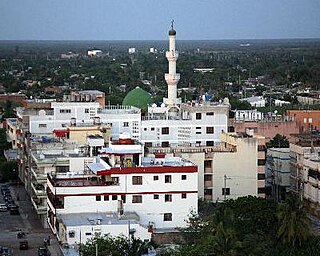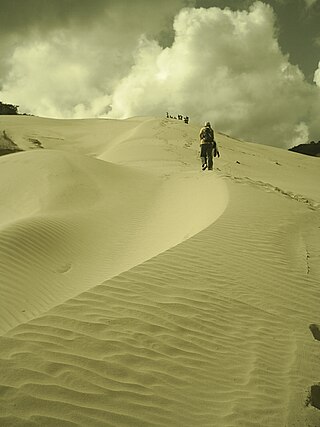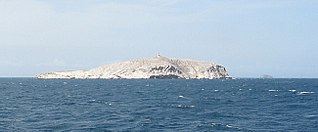


Punta Gallinas (Cape Gallinas, "Cape Hens") is a headland in northern Colombia. It is the northernmost point on the mainland of South America, and one of the extreme points of South America. [1]



Punta Gallinas (Cape Gallinas, "Cape Hens") is a headland in northern Colombia. It is the northernmost point on the mainland of South America, and one of the extreme points of South America. [1]
Punta Gallinas is situated in the northern part of the department of La Guajira, on the coast of the Caribbean Sea.
The cape is at the northern tip of the Guajira Peninsula (Península de la Guajira) in the municipality of Uribia, about 150 km (95 mi) northeast of Riohacha.
The area has been populated by the indigenous Wayuu people for a long time.
The headland is also the location of the northernmost lighthouse in South America, the 18 m (59 ft) high Faro de Punta Gallinas, which opened in 1989. [2]
The extreme points of South America are the points that are farther north, south, east or west than any other location on the continent. The continent's southernmost point is often said to be Cape Horn, but Águila Islet of the Diego Ramírez Islands lies further south.

The Gulf of Venezuela is a gulf of the Caribbean Sea bounded by the Venezuelan states of Zulia and Falcón and by La Guajira Department, Colombia. The western side is formed by the Guajira Peninsula. A 54 km (34 mi) strait connects it with Maracaibo Lake to the south.

The Guajira Peninsula[ɡwaˈxiɾa] is a peninsula in northern Colombia and northwestern Venezuela in the Caribbean. It is the northernmost peninsula in South America and has an area of 25,000 km2 (9,700 sq mi) extending from the Manaure Bay (Colombia) to the Calabozo Ensenada in the Gulf of Venezuela (Venezuela), and from the Caribbean to the Serranía del Perijá mountains range.

Maicao is a city and municipality in the Department of La Guajira, northern Republic of Colombia. It is located 76 km from Riohacha, the capital of the department and is the second largest urban center near the border with Venezuela, after the city of Cúcuta.
Cape Bauld is a headland located at the northernmost point of Quirpon Island, an island just northeast of the Great Northern Peninsula of Newfoundland in the Canadian province of Newfoundland and Labrador.

The La Guajira Desert is a desert located in northern Colombia and Venezuela, approximately 1,100 km (680 mi) north of Bogotá, covering most of the La Guajira Peninsula at the northernmost tip of South America. It is the continent's largest desert north of the equator. Most of the region is within Colombia's La Guajira Department, though a small portion is in the Venezuelan state of Zulia. The area holds immense coal reserves which are exploited in a zone known as El Cerrejón. It is also home to the indigenous Wayuu people. The Wayuu are mostly herders but also master deep-sea divers, known for collecting pearls from the Caribbean Sea.

Cap de Formentor is the northernmost point of Mallorca, on the Formentor peninsula.

La Guajira is a department of Colombia. It occupies most of the Guajira Peninsula in the northeast region of the country, on the Caribbean Sea and bordering Venezuela, at the northernmost tip of South America. The capital city of the department is Riohacha.

Uribia is town and municipality of the La Guajira department of Colombia. It is the youngest municipality of this Department since the year 2000. Northern Zone of the Cerrejón coal mines are located in this municipality. The municipality also contains the Serranía de Macuira mountain range which is an isolated low altitude mountain range in the middle of La Guajira Desert. One third of this mountain range is also a National Natural Park of Colombia.

The Los Monjes islands is a federal dependency of Venezuela are located to the northwest 80 kilometres of the Gulf of Venezuela, 34.8 kilometres off the coast of Guajira Peninsula at the border between Colombia and the Venezuelan state of Zulia.

Bahía Portete – Kaurrele National Natural Park is a national natural park in Uribia, La Guajira, Colombia. The northernmost national park of mainland South America is located at the Caribbean coast of the La Guajira peninsula in Bahía Portete, between Cabo de la Vela and Punta Gallinas. Established on December 20, 2014, it is the most recently designated national park of the country. As of 2017, 59 nationally defined protected areas are incorporated in Colombia. The park hosts a high number of marine and terrestrial species.

The Santacrucian age is a period of geologic time within the Early Miocene epoch of the Neogene, used more specifically with SALMA classification in South America. It follows the Colhuehuapian and precedes the Friasian age.
The Friasian age is a period of geologic time within the Early Miocene epoch of the Neogene, used more specifically within the SALMA classification of South America. It follows the Santacrucian and precedes the Colloncuran age.

Cabo de la Vela is a headland in the Guajira Peninsula in Colombia with an adjacent small fishing village. It is a popular ecotourism destination of the Caribbean region of Colombia.
This is a list of the extreme points of Colombia, the points that are farther north, south, east or west than any other location.
The Cocinetas Basin is a small sedimentary basin of approximately 1,000 square kilometres (390 sq mi) in northeasternmost Colombia. The onshore pull-apart basin is located in the department of La Guajira at the border with Zulia, Venezuela. The basin is bound by three sets of hills; the Serranía de Jarara, Serranía Macuira and Serranía Cocinas, with the eastern boundary formed by the Gulf of Venezuela, part of the Caribbean Sea.
The Castilletes Formation is a fossiliferous geological formation of the Cocinetas Basin in the northernmost department of La Guajira, Colombia. The formation consists of fossiliferous mudstones, siltstones and medium-grained to conglomeratic fossiliferous lithic to quartzitic sandstones. The Castilletes Formation dates to the Neogene period; Burdigalian to Langhian stages, Colloncuran and Friasian in the SALMA classification, and has a maximum thickness of 440 metres (1,440 ft).

Nansen Land is a peninsula in far northwestern Greenland. It is a part of the Northeast Greenland National Park.